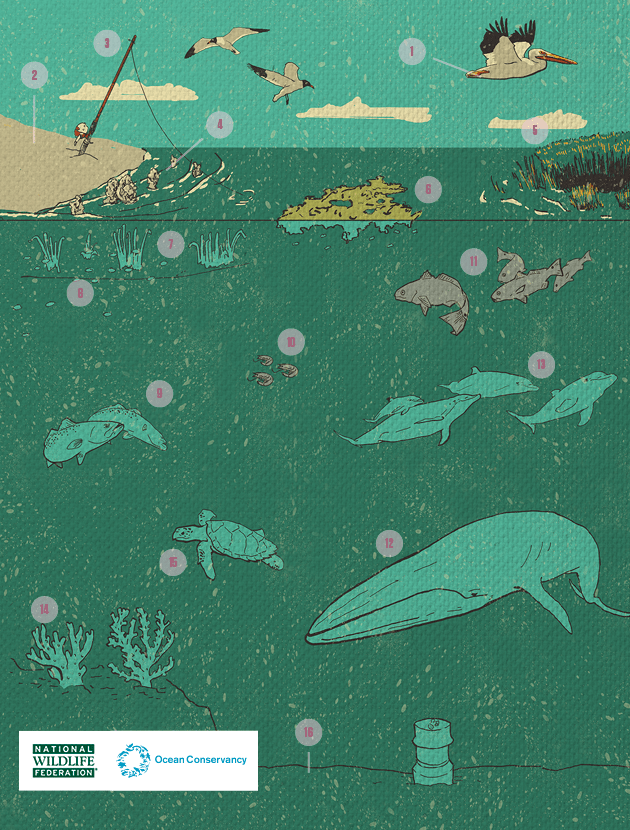We have much more to do and your continued support is needed now more than ever.
What We Know Now About the BP Oil Disaster
It’s been more than five years since the Deepwater Horizon oil rig exploded. Since that time, a council of federal and state Trustees have been extensively investigating the impacts of the disaster on wildlife and habitats, but that information has been kept under wraps—for use in litigation against BP. Now that the case has settled, this research has finally been made public in a draft Programmatic Damage Assessment and Restoration Plan.
The impacts to wildlife and their habitats are shocking and far reaching. Despite clean-up efforts and the natural weathering processes over the five years since the spill, oil persists in some habitats where it continues to expose resources in the northern Gulf of Mexico. In many cases, the damage to wildlife and habitats was more severe than previously understood. The ecological linkages of these habitats and communities and their connectivity to the larger Gulf of Mexico ecosystem can result in cascading impacts, influencing the overall health and productivity of the Gulf of Mexico ecosystem.
Together, the National Wildlife Federation and Ocean Conservancy scientists have worked to dig in to the massive report and digest its findings. Here is a snapshot of the types and severity of impacts outlined in the draft report.
1. Birds
While the Trustees acknowledge that this is a very conservative estimate, the total number of birds killed by the BP oil disaster is from 56,100 to 102,400 birds. At least 93 species of birds across all five Gulf Coast states were exposed to oil.
2. Beach & Dune Habitat
BP oil covered at least 1,300 miles of the Gulf coastline, including 600 miles of beach, dune and barrier island habitat.
3. Lost Human Use
The public lost 16,857,116 days of boating, fishing and beach-going experiences. The total loss of recreational use of the Gulf due to the disaster is worth $528 million to $859 million.
4. Oysters
Between 4 and 8.3 billion oysters are estimated to have been lost. Over three generations (minimum recovery time), the dead oysters would have produced a total of 240 to 508 million pounds of fresh oyster meat.
5. Salt Marsh
Louisiana lost up to 53 percent of its salt marsh plants across 350-721 miles of shoreline. In Louisiana wetlands, erosion rates approximately doubled along at least 108 miles of shoreline. The effect lasted for at least 3 years.
6. Sargassum
Sargassum, a floating seaweed that provides habitat for young fish and sea turtles, was exposed to oil, which may have caused the loss of up to 23 percent of this important habitat.
7. Seagrass Habitat
Seagrass beds covering a total area roughly the size of 206 football fields (272 acres) were lost from the time of the disaster through 2012.
8. Larval Fish
The Trustees estimated that 2-5 trillion larval fish were killed. The loss of larval fish likely translated into millions to billions of fish that would have reached a year old had they not been killed by the BP oil disaster.
9. Sea Trout
Several of species of sea trout, including the spotted (or speckled) sea trout, were severely impacted by the disaster. An estimated 20-100 billion sea trout larvae were killed as a result of the disaster.
10. Shrimp
The growth of young white, pink and brown shrimp was dramatically affected by oil. The total loss of shrimp production over 2010 and 2011 due to oiling is estimated at more than 2,300 tons.
11. Red Drum
The growth of young red drum fell by up to 47 percent along marsh shorelines in Louisiana that were persistently oiled since 2010, and an estimated 700 tons of red drum were lost. Reduced red drum production persisted through 2013 and is expected to continue.
12. Whales
While nearly all of the species of whales in the footprint of the oil have demonstrable, quantifiable injuries, the most hard-hit was the Bryde’s whale. With only about 50 Bryde’s whales left in the Gulf, roughly half of these animals were exposed to oil—and nearly a quarter were killed. It is unclear if Bryde’s whales will be able to recover.
13. Bottlenose Dolphins
The number of bottlenose dolphins in Barataria Bay and Mississippi Sound—two areas particularly affected by the disaster—is projected to decline by half. The populations are expected to take 40-50 years to recover. In the 5 years after the oil disaster, more than 75 percent of pregnant dolphins observed within the oil footprint failed to give birth to a viable calf.
14. Coral Reefs
The footprint of injury to mid-depth coral reefs is just over 4 square miles. These areas along the continental shelf edge, known as the Pinnacles, showed extensive damage to both the coral colonies and the reef fish associated with them. The larger ecological functions of this habitat were very likely impaired.
15. Sea Turtles
All five of the Gulf’s sea turtles are either threatened or endangered. It is estimated that somewhere between 61,000 and 173,000 sea turtles—of all ages—were killed during the disaster. For the endangered Kemp’s ridley sea turtle, this equals 10-20 percent of the average number of nesting females each year, which would have laid approximately 65,000 – 95,000 additional hatchlings.
16. Deep Seafloor
The footprint of BP oil on the Gulf seafloor around the wellhead is an area more than 20 times the size of Manhattan (over 770 square miles). An additional 3,300 square miles may have been affected.
Click here to download a printable version of the graphic and impacts data (PDF).
Ensuring Comprehensive Restoration
It is essential to track the healing of the ecosystem from the disaster in order to steer restoration decisions. What is unknown—and unknowable at this time—is how these effects might trigger additional cascading impacts that could further impair the health of the Gulf of Mexico.
Collin O’Mara, president and CEO of the National Wildlife Federation, said this about these new revelations of impacts to Gulf wildlife:
Helping the Gulf of Mexico recover from this unprecedented disaster should be a national priority. Ultimately, as much as $16 billion in criminal penalties, the RESTORE Act dollars, and the Oil Pollution Act fines will be available for restoration efforts across the Gulf. Ensuring that this money goes where it can do the most good will require commitment and coordination—we’re on the ground in all five states working to make sure this happens.























